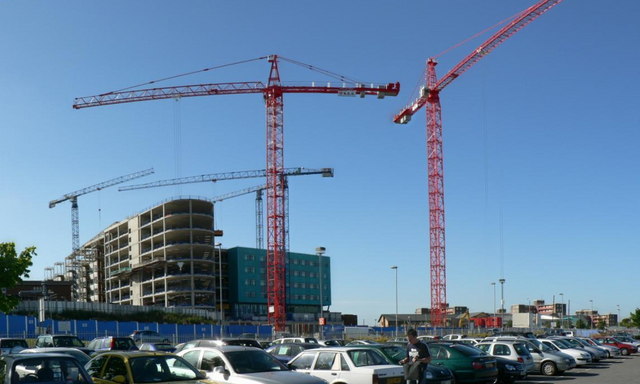To understand how tower cranes work, it is imperative to know their definition and their main components.
Tower cranes are major construction equipment normally seen at sites involving tall building under construction. Tower crane are often used to lift steel, concrete, large equipment like generators, and other construction materials.
Parts of tower cranes
Tower cranes consist of three major parts: The Base, the Master and the slewing unit
- The base is bolted to a large concrete slab.

Tower crane base - From the slab rises the mast of the crane),
- This vertical part connects to the slewing unit enabling the crane to rotate
Tower cranes cannot handle heavy weights as handled by gantry cranes at ship yards. The limitation for lifting weight starts from the base of the tower crane. Each every component of the tower crane affects the load lifting capacity of the tower crane. For a typical tower crane,
Maximum unsupported height – 80 meters (265 feet),
If the crane height is more than 265 feet, then some means of sturdy support is required. It may be some steel wires fixed from the crane mast to the different parts of the building.
Maximum Reach – 70 meters (230 feet),
Maximum Lifting Power – 19.8 tons (18 Metric Tons), 300 tonne-meters
Counter weights – 20 tons (16.3 Metric Tons).
The maximum weight that a tower crane can lift is 18 Metric Tons. However, it has to be understood that the quantity of weight to be lifted keeps on decreasing as the distance from crane center increases. So, it is always better to lift loads keeping them as close as possible to the crane’s center.
Read More:How a generator works to create electricity
The factor 300 tonne-meter is instrumental in understanding the load limitation. It is the moment of the load lifted about the crane’s center. So moment = load * distance.
A 300 tonne-meter limit can be inferred as a load of 10 tons being lifted at a distance of 30 meters from the center of the crane. So moment about the crane’s center is 10 tons * 30 meters = 300 tonne-meter.
Basic Safeties for a Tower Crane with respect to load being lifted:
Maximum load limit switch
This switch along with its accessories monitors the pull (strain) on the cable and thus does not allow the maximum load limit to cross 18 tons, after which it trips the motor and gives audible and visual alarms.
Load moment limit switch
This limit switch along with its accessories ensures the load-moment (tonne-meter) rating does not exceed beyond the given limit, after which the hoist motor and traversing motors are tripped with audible and visual alarms.
These towers are held at the base by concrete structures/pads, with the help of anchor bolts. These concrete slabs are made ready several weeks before the arrival of the tower cranes. These concrete pads weigh about 2 tons.
Erection Sequence: Points to note
The erection sequence must be strictly followed as even a small error may create huge devastation.
For erecting and before put into use, surveyors are designated for inspections and checks to be carried out on the crane structure and the load limits.
Trained operators are licensed and examined before operating these cranes. Their education includes various levels of examinations and fitness check for operating at huge heights.
These operators are well-versed with the load distribution systems and they keep monitoring the stresses and abnormalities when lifting through a computer which is programmed to calculate the bending and load moment calculations.

